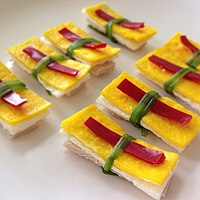Species of plant
| Oenanthe javanica
|

|
|
|
|
|
Scientific classification 
|
| Kingdom:
|
Plantae
|
| Clade:
|
Tracheophytes
|
| Clade:
|
Angiosperms
|
| Clade:
|
Eudicots
|
| Clade:
|
Asterids
|
| Order:
|
Apiales
|
| Family:
|
Apiaceae
|
| Genus:
|
Oenanthe
|
| Species:
|
O. javanica
|
| Binomial name
|
Oenanthe javanica
|
| Synonyms[2]
|
- Cyssopetalum javanicum Turcz.
- Dasyloma corticatum Miq.
- Dasyloma japonicum Miq.
- Dasyloma javanicum (Blume) Miq.
- Dasyloma laciniatum (Blume) Miq.
- Dasyloma latifolium Lindl.
- Dasyloma subbipinnatum Miq.
- Falcaria javanica (Blume) DC.
- Falcaria laciniata (Blume) DC.
- Oenanthe decumbens Koso-Pol.
- Oenanthe kudoi Suzuki & Yamam.
- Oenanthe normanii F.P. Metcalf
- Oenanthe stolonifera Wall. ex DC
- Oenanthe subbipinnata (Miq.) Drude
- Phellandrium stoloniferum Roxb.
- Sium javanicum Blume
|
Oenanthe javanica, commonly Java waterdropwort,[3] water celery,[4] water dropwort,[5] Chinese celery,[4] Indian pennywort,[6] minari and Japanese (flat leaf) parsley,[4] is a plant of the genus Oenanthe originating from East Asia. It has a widespread native distribution in temperate Asia and tropical Asia, and is also native to Queensland, Australia.[6]
This plant should not be confused with the plants of the genus Cryptotaenia, sometimes called "Japanese wild parsley" (mitsuba in Japanese), Apium graveolens var. secalinum which is also called "Chinese celery", or other plants called "water dropwort" and "water celery".
Description
Oenanthe javanica is a perennial herb that grows to about 1 m in height, with fibrous roots that emerge from all nodes, and flowers with 5 white petals and 5 stamens. The leaves are aromatic, glabrous, and have a sheath covering the stem. The leaflets are divided into lobes and crinkled.[7] The 'Flamingo' variety has colorful pink edges. The plant grows wild in moist areas, along streams and on the edges of ponds.[citation needed]
The plant is considered officially invasive in several states of the United States.[8]
Culinary use
While many other species of Oenanthe are extremely toxic, Oenanthe javanica is edible, and is cultivated in China, India, Japan, Korea, Indonesia, Malaysia, Thailand, Taiwan, and Vietnam, as well as in Italy, where its spring growths are relished as a vegetable.[citation needed]
India
Known locally as komprek (Meitei: ꯀꯣꯝꯄ꯭ꯔꯦꯛ[9]), it is commonly consumed in the Northeast Indian state of Manipur, where it is one of the main ingredients in Manipuri eromba and singju.[citation needed]
Japan
Called seri (セリ) in Japanese, it is one of the ingredients of the symbolic dish, Nanakusa Gayu, consumed on 7 January.
Korea
In Korea, the plant is called minari (미나리) and is eaten as namul vegetable.[10] The 2020 drama film Minari is named after the vegetable.[11]
-
Minari-muchim (seasoned water dropwort salad)
-
Minari-oi-muchim (seasoned water dropwart and cucumber salad)
-
Minari-buchimgae (water dropwort pancake)
-
Minari-ganghoe (water dropwort rolls)
Constituents
The plant contains persicarin and isorhamnetin.[12]






